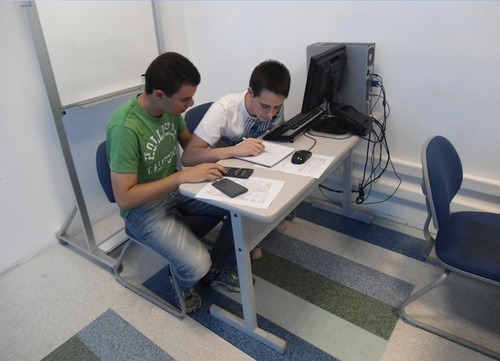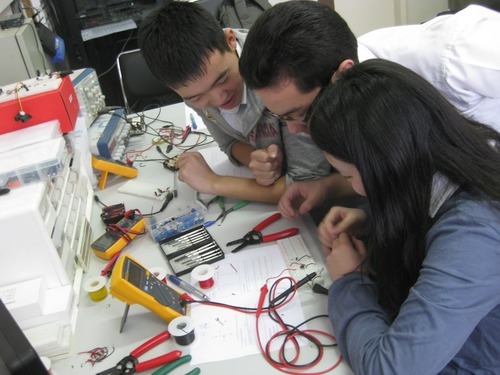More FIX on the NET @ FIX University Cultural Campus
Welcome to Spring Semester 2013
The Best College Radio Stations
Beyond The Circuits: A Student’s Experience with 6.002x
Reflection by Arthur Amaral
Note: Arthur, an 18-year-old Brazilian student, sent us this reflection after taking 6.002x in the spring.
“A course with certification from MIT? Sounds like a challenge!”
That’s how it all began.
My name is Arthur Amaral and I am an 18-year-old student in Brazil. Recently I finished high school and graduated as an electronics technician from a public institute of technology.
I took 6.002x along with a long-term friend of mine, Ricardo, who shares the same background. With little knowledge of calculus and physics, we knew that we were kind of going in blind.
I took a look at the main page before signing up; it estimated that we would end up spending around 10 hours per week with 6.002x. With a tough schedule, I wondered, “Is it worth it?” Fortunately, I did not turn this opportunity down. Instead, Ricardo and I dove head-first into this experience.
From the start, I could see how much effort was put in building 6.002x. I could see that there was a well-structured staff that was chosen to design a platform that could connect students all over the planet. Navigation was simple, and both written and video tutorials by Lyla Fischer about the system were great.
Then I began watching the lectures. At first sight, it looked like stuff that I already knew, but I then later realized that it went way beyond that. I was seeing everything from a new perspective. Professor Agarwal had a lot of contagious enthusiasm. Piotr Mitros and Gerry Sussman’s tutorials were a great extension to the class, providing useful examples and developing a more practical understanding of topics. Finally, the staff’s videos on problem-solving gave me extra confidence and helped me think more outside of the box.
But then again, we had deadlines to deal with, and we felt a sample of MIT’s standards. Homeworks and labs weren’t simple and demanded a deep understanding of the subject. It was not always fun: it was frustrating as the challenges demanded the application of the lecture concepts to things way more complicated. But when the green tick finally appeared, the amount of satisfaction was unmatched.
It was also not easy to manage our time. Our jobs were very demanding and we had little time to spare. Not only that, but I had to balance my job with pre-university studies, and taking one more course would mean extra deadlines to deal with. I learned to cut out some time-wasting habits (unnecessarily checking social networking websites, for example) and concentrate on my own education. Those are practices that I intend to carry on with for as long as I can!
One of the best things about 6.002x was the community built by the students themselves. The atmosphere was great: people shared their enthusiasm and knowledge, and lended a hand to those like me who didn’t have the basics for the course. All of this was done in a very friendly environment. This was something that really helped me keep moving forward in 6.002x.
But it’s even better when you can study with a friend!

Ricardo (on the left), and me preparing for the final exam
6.002x required some intense studying from us, but thankfully, we were given the right directions. We had never had to actually solve differential equations before, for example, but Khan Academy, along with insights given by other students, formed the mathematical bridge that we needed to be successful.
Although we studied together, the Honor Code was really a matter of honor for us. When doing homework, labs and exams, we wanted to see how far we could without helping each other; without surrendering. It was never a competition, but we did our best to get a grasp of what an MIT student goes through.
The exams were pretty hard, as anyone would expect from such university. However, it was a direct application of what we learned so far combined with the difficulties of the everyday engineering. Like Professor Agarwal says, we are given a set of tools to analyze, create and fix all those circuits, but it’s up to us how we are going to use them.

A picture to illustrate my post-final-exam situation
All of the fun obstacles and study groups formed within the forums made me rethink my own career. It was like seeing a new horizon: I realized that there is so much excitement that can come from learning. This course not only boosted my confidence in my technician degree, but also changed the way I see my own future.
Currently, as a monitor of electronics, I feel inspired once more to pursue my dream to become researcher and educator. I would like to help other people as much as I can to feel this same joy I felt here, and provide guidance for those who seek to know more about the world. Thank you, 6.002x for reigniting my aspirations and so positively changing my life. I hope many more students will be able to feel the same.
On a final note, I would like to bring up this quote by Professor Agarwal and the edX team: “Our goal is to educate one billion people around the world.”
This might be a dream, but rest assured that you aren’t the only dreamers! Please never give up from this goal.
Bringing MIT Course Content to High School Students in Developing Countries: 6.002x in Mongolia
By Shilpa Agrawal

In March, Tony Kim, a PhD student at Stanford University with an undergraduate degree in electrical engineering and computer science from MIT, traveled from the palm trees of Palo Alto to Ulaanbaatar, the capital city of Mongolia — a landlocked, developing country in central Asia. He left California with a focused goal in mind: to teach a group of motivated high school students electrical engineering through hands-on laboratory experience.
As Tony was packing his bags and preparing for his three-month trip to Mongolia, he received an email out of the blue from one of his soon-to-be students, Battushig. This enterprising 15-year old student from the Sant School, where Tony would set up his experimental lab, was requesting that Tony bring along with him some TSAL6400s – an infrared LED – so that he could implement a project he had read about on the Internet.
Surprised and impressed that this student had taken the time to read about the part and was excited about the project, Tony rush-shipped 100 TSAL6400s over to his home in California, and before Battushig even knew it, the parts were on their way from the States to Mongolia.
By chance, Tony’s experimental effort coincided with the launch of 6.002x – the edX version of MIT’s introduction to electrical engineering class – and it was clear that these two initiatives could work together.
Tony believed that there were exceptional students in the developing world who were going unnoticed by the world’s best colleges, and he wanted to open doors for them.
And he did.
Using a flipped classroom model, Tony guided the Mongolian high school students through 6.002x, a class that is typically taken by sophomores at MIT. His students would watch the 6.002x lectures at home then Tony would meet with them everyday for several hours in groups of two to three to do the experimental labs, review the material, and work with them on problem solving. The group learned to work together to overcome language barriers (some of the students could not speak English fluently), to study for upcoming midterm and final exams, and to build circuits during labs.
At the end of the semester, ten high school students passed the course, two of whom got A’s in the course, Buttushig got a 100% on the final: one of 340 6.002x students out of 150,000 in the world to do that. Even after the course has ended, some students are continuing their experience with electrical engineering by building electronics labs in their homes and trying out new experiments every week.
Tony and his MIT classmate and colleague on this adventure, Enkhmunkh Zurgaanjin — the first student from Mongolia to attend MIT, were driven to introduce this challenging courseware to their students, and with a budget of just $3000, they wanted to do something that would be cost-efficient, sustainable, and valuable for the students. Perhaps one of the biggest downsides to the Mongolian education system is that there is little infrastructure for students to further their education beyond the state-mandated curriculum. In Mongolia, the AP and IB curricula are not wildly available and so, at no cost, the 6.002x curriculum served and can continue to serve as one of the most challenging outlets for students to take high-level courseware. After completing edX courses, the students can also potentially use the certificate of completion to strengthen their applications to colleges.
Tony was impressed by all of the students in the class, but especially by 15-year old Battushig, who never received any special education abroad and who mastered everything in 6.002x.
Battushig requested the TSAL6400 to implement the Wiimote Smartboard, an infrared pen that turns any projection into an interactive smartboard. After successfully completing the project, Battushig became excited about the ways it could improve his community and he went on to create the first ever presentation of the Wiimote Smartboard in Mongolian, and introduced it to teachers at his school so they could use the pen on the board to better their classroom experience. Every day Battushig would come up with new questions and new ideas on how to apply his theoretical knowledge with practical, hands-on experiments, and everyday he was motivated to continue learning, continue building, and continue problem-solving – all at his own pace.
In his three months there, Tony worked with high school students who are excited about engineering, excited about using solar panels to build circuits during sporadic power outages, and excited about having connections with courseware taught at institutions such as MIT and Harvard.
EdX gave the students at Sant School an opportunity to be challenged, to become accomplished in new technologies, and to gain credibility for their work. It gave them the tools to understand the theory behind gadgets like the Wiimote Smartboard, and it gave them the motivation to actually implement these projects. With the help of Tony and Enkhmunkh, the students were able to form a community and build a support network to help one another excel at the courseware. As edX continues to grow and a greater number of courses come online, more students across the world will have this opportunity with a broader set of available courseware.
Tony believes that edX presents an opportunity for young students throughout the world to challenge and distinguish themselves. This summer he is working with edX on development, and is expanding the use of edX courses in Mongolia. To read more about the 6.002x experience in Mongolia, check out the blog that Tony kept while he was there: http://6002x.blogspot.com/.